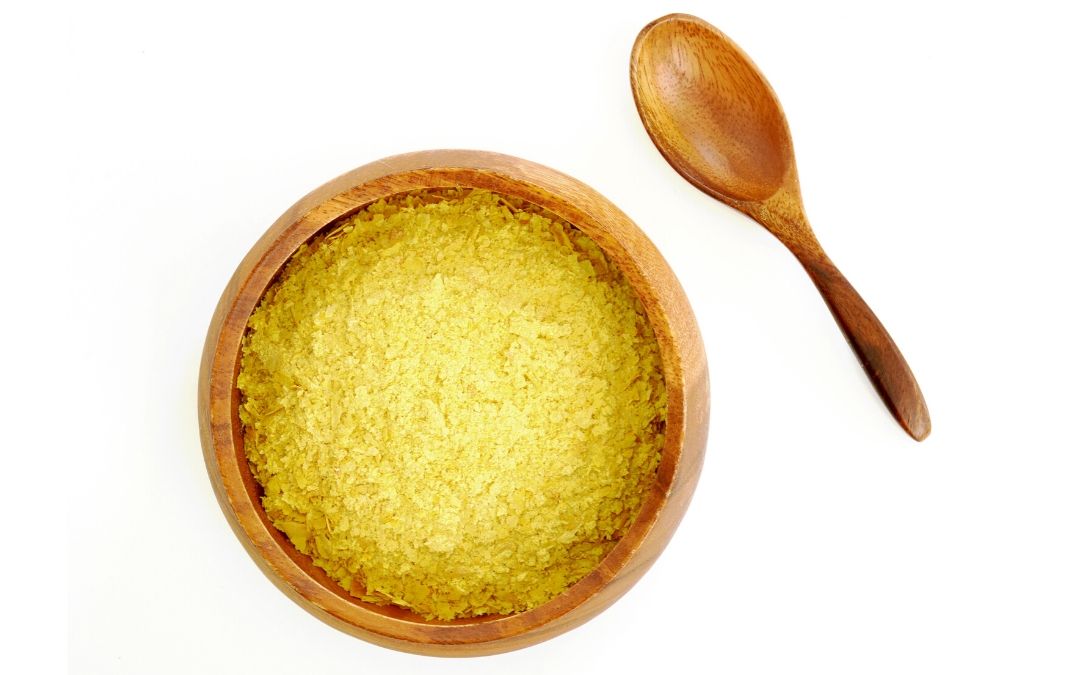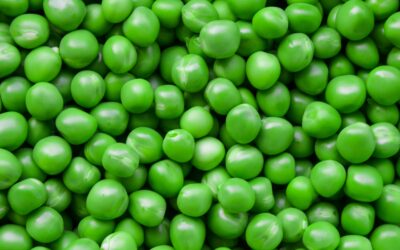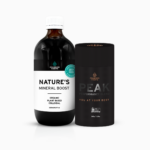Back in the 1980’s in order to get natural B vitamins the trendy thing to do was to consume brewer’s yeast or torula yeast.
Brewer’s yeast was my choice because it was the byproduct of beer brewing. Torula yeast, on the other hand, was grown on wood liquor, rich in the sugar xylose and a byproduct of paper production.
These days, these two yeasts have gone out of fashion, replaced in the most part by nutritional yeast. Nutritional yeast is made in the same way as brewer’s yeast except it is made on a different food source (eg sugar and/or molasses), specifically for the functional food market for animals and humans.
The history of nutritional yeast spans nearly 50 years – and it’s been a bumpy ride. In 1975, dried nutritional yeast flakes appeared in the form of ‘Red Star’ yeast and its nutritional content was the main draw card. It was popular until the 1980’s, when there was a high number of candida diagnoses, which prompted people to stop eating yeast. But now with the popularity of plant-based and vegan diets it, too, has gained popularity.(1)
I’ve never been a fan of nutritional yeast, possibly because I didn’t have a lot of knowledge about it and I wasn’t sure of the additives in it or how it was made – I always ask myself whether I could make it in my kitchen or grow it in my garden. And I could live without it because I wasn’t a vegan and didn’t need fake cheese.
But I couldn’t stay naïve for long because many people in the Changing Habits community keep asking about nutritional yeast. So, I’ve done some research for all the curious out there.
Around the beginning of last century, sourdough was replaced with an active yeast – saccharomyces cerevasiae (baker’s yeast) – in breadmaking. I used this yeast in my breadmaking days. As the bread dough rose, so did the proliferation of the yeast, then when the raised loaf was baked, it rendered the yeast inactive. The byproducts/metabolites of the yeast, including vitamins B1 and B2, became part of the nutritional value of the bread.
These days, with bread off many tables, and the want to eat more plant foods and less or no animal foods, nutritional yeast has increased in popularity. It makes vegan cheese taste cheesier; it has an umami taste to it so it can be used to flavour otherwise bland savoury foods.
What is Nutritional Yeast?
In its basic form, it is a bunch of saccharomyces cerevasiae cells that make nutrients and other metabolites using a substrate (food) in order to multiply and grow. These yeast cells are then rendered inactive, pasturised and dried and fed as a protein and nutrient source to humans and animals. It is sometimes called ‘nooch’.
The nutritional values for nutritional yeast will vary from one manufacturer to another. On average, two tablespoons has 60 calories which is made up of 5 grams of carbohydrates, 4 grams of fiber and 9 grams of protein, providing all the essential amino acids. It also contains minerals, some trace minerals and vitamins B1 and B2. The yeast does not produce B12 and the amount of folate it produces will depend on the substrate/food it is grown on. (2)
It’s interesting to note that, despite baker’s yeast being saccharomyces cerevasiae, in Australia in 2009 there was a mandatory fortification of flours and breads with folic acid (a synthetic form of folate). So, if you see B12 and folate on the nutritional label of your nutritional yeast, then it may be fortified rather than being a natural metabolite of saccharomyces cerevasiae.
Yeast glucan is also present but in smaller amounts compared to the amino acid content. This is a polysaccharide that has proven health benefits including lowering cholesterol, improving blood sugar management and boosting the immune system. These glucans are found in the cell walls of bacteria, fungi, yeasts, algae, lichens and plants. So even if you don’t eat nutritional yeast, you won’t miss out as they are in many foods.
All inactive yeast contains amounts of glutamic acid. When the yeast cells die the proteins in the cell wall of the yeast degrade, breaking down into amino acids. Glutamic acid is a naturally occurring amino acid found in yeast, animals and vegetables and is used in the food industry as a flavor enhancer in its salt form, known as monosodium glutamate (MSG).
So, if you have a tendency to be sensitive to this excitatory compound it would be advisable not to consume nutritional yeast. Yeast extract and MSG are often used as flavour enhancers and that’s why nutritional yeast has the ability to flavour bland foods.
I’ve read varying reviews on nutritional yeast, all the way from it’s the worst thing you could eat (because it’s processed and contains mycotoxins), to it’s the best.
So, I decided to investigate. My main consideration when doing so was: is it an ethical food that will do no damage to the health of humans and the planet?
It seems saccharomyces cerevasiae is well known in the world of microbiology. It is the second most-favoured microorganism after E. coli to be used in biotechnology (genetic modification of microbes) to manufacture food additives, pharmaceuticals, supplements and other useful products for modern-day living including plastic and fibres.(3) This is called synthetic biology and you can read about it in my blog A Synthetic Route to Natural.
If you have read my work before you will know that the first thing I want to determine when investigating a food is how it is manufactured or made. Most ingredients have patents, so I look them up and then search Alibaba and get the spec sheets from a bunch of companies that sell and/or make the product in bulk.
The nutritional yeast patents I read ranged from it being made using genetically modified yeast cells, to old strains of yeast cells. The substrate that the yeast cells were grown on also ranged from sugar beet that is usually GMO with traces of glyphosate, to an organic food or substrate. As you can imagine, if the manufacturers have gone to the trouble of purchasing non-GMO yeast cells then they probably will also use non-GMO food sources for the yeast to grow on (and vice versa).
Other things can be added to the food source that the yeast grows on including ammonium sulfate, potassium phosphate, potassium chloride and magnesium sulfate. Then, according to one patent, the process goes something like this:
“The method involves washing and removing mustard from food yeast; providing autolysis, boiling out and drying procedures. At autolysis stage, yeast suspension is diluted with water used in the ratio of 1:1 at temperature of 500C and pH value of 5; holding while mixing for 60-90 min. After autolysis operation, preliminarily diluted enzyme preparation of amylorisin is introduced into diluted mass in an amount of 0.2% by weight of basic amount of yeast and held at temperature of 500C for 5-6 hours, with mixing being provided during holding period. Mustard is removed from food yeast by means of sodium bicarbonate. Method allows clear and transparent product with increased content of substances useful for human organism”.(4)
The processing of the yeast cells does differ. This can include using a different temperature, adding other enzymes and/or variations of the above paragraph.
Then things may be added to the nutritional yeast like rice flour, salt and sometimes emulsifiers. If it is made into a food, many other things can be added like milk powder, maltodextrin, lactose, plant grease powder, calcium carbonate, starch, white granulated sugar, flavoring agent and/or essence.
Nutrients can be added to fortify the nutritional yeast including folic acid, B group vitamins, vitamin A, vitamin C, selenium-enriched yeast, zinc-enriched yeast, chromium-enriched yeast, iron-enriched yeast, microcrystalline cellulose, dehydrated scallion flake, cocoa powder, fruit and vegetable powder, sesame, milk tea powder, soy milk powder, oat flake…
The nutritional yeast food can then be made into powder, flake and/or tablet, which are manufactured through various methods.
There are some incredible manufacturers that I found with impeccable ethics about non-GMO yeast, non-GMO substrate and adding nothing to the dried nutritional yeast. I love their story and I also love what they stand for. They may manufacture some things that I don’t agree with, but if you were going to use nutritional yeast, I think they would be the best company to purchase from. But the issue is, they are the manufacturers and do not sell retail.
So, people buy from them (or other manufacturers) and then repackage the product and sell it to the public. The problem is that if you don’t know the source of your nutritional yeast, then you may be getting an inferior nutritional yeast.
You will not know whether other ingredients have been added unless you call the packager and ask for the spec sheet of the nutritional yeast – this will tell you all the ingredients.
You see, there is a flaw in the ingredient laws. If a food producer buys from a manufacturer and the ingredients on the spec sheet says nutritional yeast, rice flour and salt, the producer only has to list ‘nutritional yeast’ and not the other two ingredients as they are considered minor additives. I see this with instantized whey powder all the time. In order for it to be instant, usually a dried canola oil and emulsifier needs to be added, but those two ingredients don’t make the ingredient list.
Fortification of nutritional yeast does happen. Consider how the vitamins are made (via biotechnology or another process) and where the minerals are sourced – from a plant or from a mine.
After my research, I decided that if I knew that the source of the nutritional yeast was a reputable manufacturer and that it was not fortified, nor was anything added to it, I wouldn’t mind having it on occasion. But the real issue is the manufacturing process – it’s not something that I can make at home.
Having said that, I have found an alternative to nutritional yeast that you can make with just two ingredients in your own home, miso and sprouted chickpeas. Make sure your ingredients are organic, as the chickpea crop can be sprayed with Roundup just before harvest. Watch the recipe here: https://www.youtube.com/watch?v=KNJ89In6MBE
So, it’s up to you whether you can be bothered to source the naked, non-GMO nutritional yeast. Remember that, if you see it added to a product like vegan cheese or something of the sort, you will never know what exactly the product contains because I’m sure if you call the manufacturer they will be none the wiser.
References
2. https://pubmed.ncbi.nlm.nih.gov/18234383/
3. https://www.asmscience.org/content/book/10.1128/9781555816827.ch20
4. https://russianpatents.com/patent/212/2128702.html
Further Reading
https://blog.daveasprey.com/nutritional-yeast/
https://www.westonaprice.org/health-topics/abcs-of-nutrition/nutritional-yeast/
https://patents.google.com/patent/WO2010069191A1/en








Oh boy…does the word “brewers yeast” bring back memories! When my son was born back in the 60s I was having trouble breast feeding him. The doctor suggested brewers yeast to help increase my milk production (he weighed 10.5 lbs. when he was born and I couldn’t keep up with him). Once I got used to the taste, I found that I was much healthier (I guess that’s why I like Guiness so much). Anyway, I loved this article. bernie
Hi
Really enjoyed this article. Is out possible for you to share which manufacturers you found had non-GMo practices please?
I look forward to getting to read the rest of your blog.
Cheers
Mags
Hi Mags, the name of the manufacturer was Angel. I am not sure what brand this is sold under as they only sell this in bulk quantities?